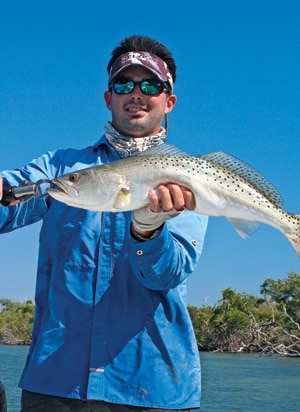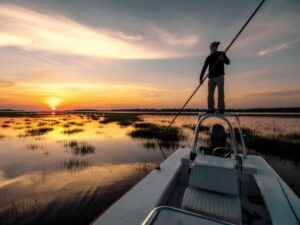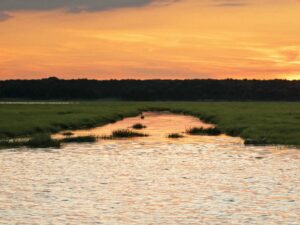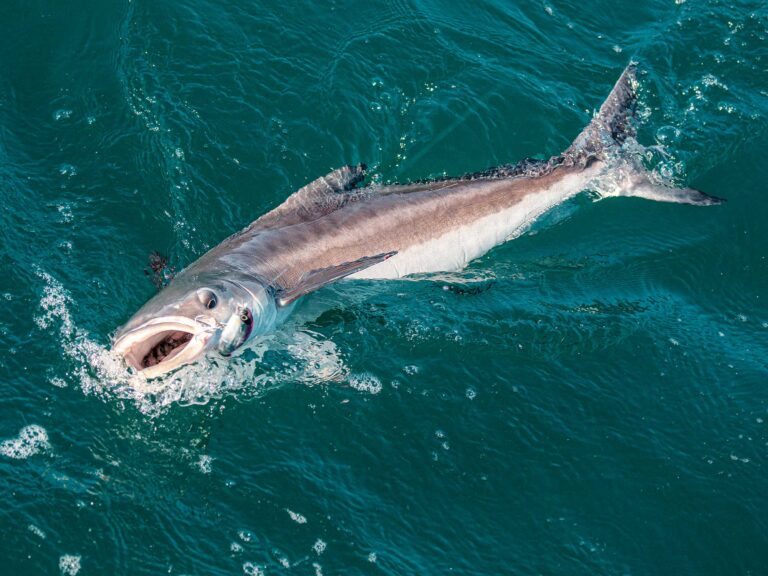
The ripples from the cast had barely receded before the bright-orange float started bouncing on the surface like a foam pinball. A frisky threadfin herring suspended underneath was swimming for its life. It lost seconds later, as the big spinning reel drag sent out a high-pitch whine, the rod bending over under pressure. Some 75 yards away, a hefty tarpon shot skyward, quicker than a rocket. The fight was on.
“You’ve got the hot stick this morning,” I said to my friend, Mike Mabry, as he clambered down from the boat’s tower station attempting to retrieve his disappearing line. “That’s your second bite in 15 minutes.” Half an hour later, after countless laps around the 24-foot bay boat, both tarpon and angler were whipped. Our guide and Mabry’s nephew, Capt. Chris Frohlich, deftly removed the hook and rubbed the fish’s outer jaw with a small pad to collect a DNA sample before sending the tired 130-pounder back into the depths of Pine Island Sound.
“Had enough?” Frohlich asked his tired relative with a sly grin. “OK, we can check tarpon off our list. Let’s go find some snook and let you catch your breath.”
A Number of Options
Mabry and I had driven to Punta Gorda, Florida, a couple days earlier to reacquaint ourselves with the variety that Charlotte Harbor has to offer. His nephew has been fishing professionally for two years, after spending his youth exploring the mangrove-lined maze of this 270-square-mile estuary. Frohlich teamed up with his good friend, Capt. Rhett Morris, to form Beyond Borders Outfitters, a charter and booking operation targeting the seasonal smorgasbord of the region.
“This place is a light-tackle paradise,” Morris says. “It has such a variety of fish that can be targeted every day. What makes it so special obviously is Boca Grande Pass. The tarpon migration is incredible. But tarpon enthusiasts have been conditioned to believe the season ends by the 4th of July when the fish move out of the pass. However, that’s when some of the most exciting light-tackle action just gets started. The fish spread out into the harbor and river mouths to feed on bait schools. Best of all, most of the seasonal guides and anglers have gone home, so there is a lot less pressure on the fish.”
When targeting summer silver kings, Frohlich prefers live threadfin herring for his bait. The morning drill starts by finding the herring schools. Diving pelicans, surface flips or flashes tip off the location; the fish finder is a backup if the bait is holding deep. A couple of throws with a 12-foot cast net is usually all it takes to fill the triple livewells aboard his Yellowfin bay boat. Once he’s loaded with ammunition, Frohlich drifts or uses his trolling motor to get into position to cast to rolling fish. His arsenal consists of Shimano 7-foot, medium-heavy Teramar spinning rods with Okuma Salina 80 reels loaded with 50-pound braided line. Five feet of 60-pound fluorocarbon leader and a 6/0 Owner circle hook complete the business end. In addition to sight fishing, he trails at least one bait behind the boat, often under a float.
“I like to pitch to rollers if we see them, but the trailing fish are the ones that typically eat,” says Frohlich. “Our summertime fish average 110 to 120 pounds, but we get plenty that push 150. On a good day we’ll land at least one, and we always expect to jump way more than that. I’ve had days where we’ve hooked more than 20 fish on a half-day charter – when they’re chewing good.”
Alternatives
On those rare occasions when the tarpon develop lockjaw, ample alternatives are readily available throughout the harbor. After our tarpon score, we turned our attention to snook, the other glamour species, in the quiet backwaters and moats surrounding the mangrove islands. A couple of years ago, Hurricane Charley really hammered the trees, but Frohlich has dozens of spots where linesiders hold around submerged dead limbs with new growth taking root.
After chumming pilchards (whitebait) within range with a mix of tropical fish food and menhaden oil, Frolich netted our day’s supply of bait. Shortly thereafter, we had a blast trying to coax these spunky gamefish out of their tackle-busting lairs. Although only a few were slot-size, the two dozen others we managed to hook were worthy adversaries on the light spinning outfits. For his inshore encounters, Frohlich uses 7-foot-6-inch Redbone spinners matched with Okuma 40 Salina reels spooled with 12-pound braid. He adds a short section of 30-pound fluorocarbon leader with back-to-back uniknots, finished with a 1/0 OwnerJ-hook attached by an improved clinch knot.
Frohlich turns the bite on by chumming with stunned pilchards. While the bigger snook were holding in potholes in slightly deeper water a short distance from the shore, so were some quality trout. Frolich’s dad, Cort, landed several spotted beauties pushing 4 pounds, while Chris scored the monster, a 6-pounder on the scale. It’s not unusual to land 40 to 50 fish up to 4 pounds on a good Charlotte trout bite, says Frohlich.
Redfish are another staple throughout Pine Island Sound and along the harbor’s eastern shoreline. Schools of fish numbering in the hundreds, many of them exceeding the 27-inch slot, are not uncommon, especially in late summer and fall. Along with whitebait, gold spoons and top-water plugs are the usual offerings for the aggressive reds.
Digging Grouper

Cruising cobia and jack crevalle are two more summertime possibilities within the harbor. Both can be spotted over the shallow sand bars and enticed with live bait and artificial lures alike. For a truly unique encounter, however, Frohlich often likes to finish up his day grouper-digging – in less than 10 feet of water! During the years he’s scouted the harbor when the water was clear, he’s been able to find and stockpile nearly 20 wrecks in depths as shallow as 8 feet. Most are commercial skiffs that were swamped after being overloaded with roe mullet before Florida’s gill-net ban was adopted. In an ironic twist, most now hold resident populations of gag and Goliath grouper, along with mangrove snapper in the summer months.
Forget the ultralight stuff here. To pull these bruisers away, we used the tarpon outfits with the drags hammered down, and we still got spanked more times than not. With quick reflexes and a little luck, we did manage to pull a few gags, including one keeper and a 25-pound Goliath out of the labyrinth. All were released with only their pride hurt. Frohlich’s best wreck conquest was an 18-pound gag taken in 9 feet of water.
“The old-timers used to call it a miracle when they landed a tarpon along with a snook, redfish and trout,” says Frolich. “Now we just add a couple more species and call that a normal day in Charlotte Harbor.”
**Trip Planner
**
WHAT: Mixed-bag action featuring tarpon, snook, redfish, seatrout and gag and Goliath grouper.
WHEN: May through September
WHERE: Charlotte Harbor, Florida
WHO: Beyond Borders Outfitters offers overnight packages aboard a modern 47-foot houseboat for the ultimate Southwest Florida experience. When booking a three-day, two-night trip, the houseboat is anchored in a strategic location in the harbor or Pine Island Sound where the guides meet the anglers every morning. The Calusa Explorer is furnished with accommodations for six, a full kitchen, bath, television and stereo. A Carolina Skiff is included as a tender to run to nearby restaurants like the Tarpon Lodge. Besides the houseboat option, there are dozens of comfortable hotels in the small coastal towns and on the barrier islands in the Charlotte Harbor area that are close to the action. The Burnt Store Marina and Resort in Punta Gorda is the base of operations for BBO (941.628.0341; beyondbordersoutfitters.com).









